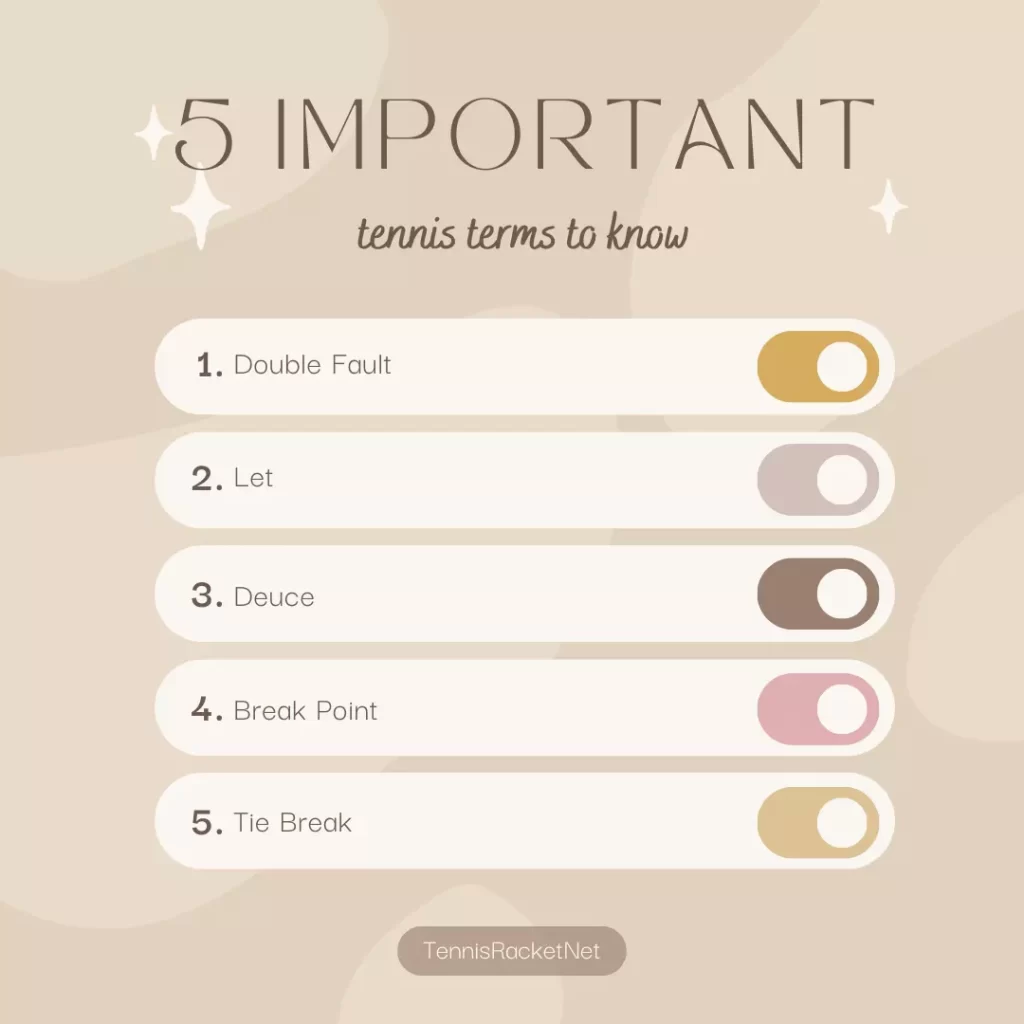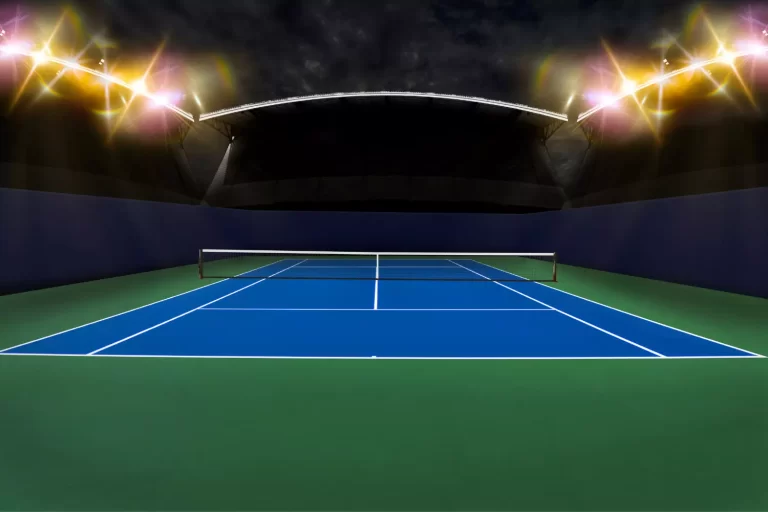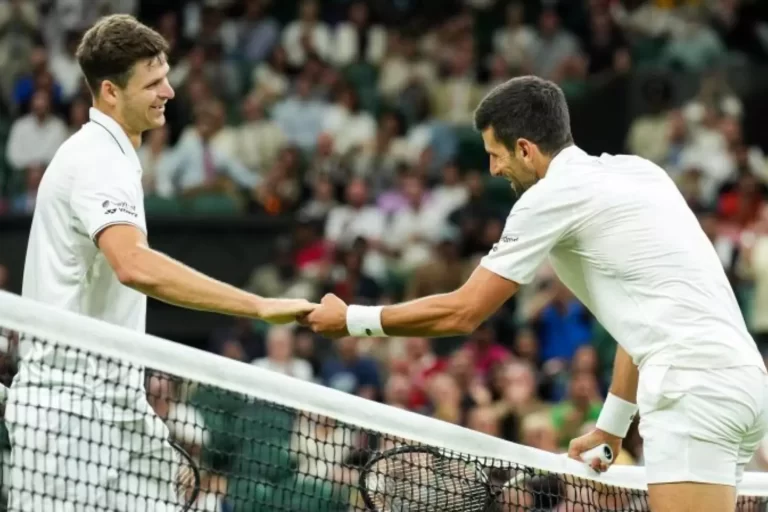What is an Ace in Tennis – Tennis Terms Explained

Are you wondering what an ace is in tennis?
A quick introduction to tennis terminology, including what an ace is, can be found in our quick guide.
Tennis has become increasingly popular around the world in recent years. With a more global sport, future professional players will have access to a wider pool of players, more media coverage, and more opportunities to play.
The terms and phrases used in tennis are quirky, especially in comparison to other mainstream sports. Tennis players throw around some quite strange words without giving them a second thought. There are several key terms that someone interested in taking up the sport should know, including an ace!
What is An Ace in Tennis?

Let’s begin with the word ‘ace’. During an ace, a player hits a serve that is so hard that the returner cannot even get a racket on it. In this case, the server wins the point by simply hitting the serve.
The speed at which the serve is delivered, or the direction in which it is delivered, is usually what enables the player to hit an ace. It’s even more effective to combine the two! Your opponent will have a difficult time responding, getting into position, and returning the ball effectively when you increase the power of your serve.
Instead of focusing on power over accuracy, the server may choose to place the ball out of reach of their opponent. In addition to improving your ace count, this tactic is also effective.
Because of their incredibly tall frames, players like John Isner and Ivo Karlovic tend to hit their aces at high speeds.
As an example, Roger Federer isn’t the greatest server of all time but instead focuses on pinpoint accuracy for his aces.
Nick Kyrgios, for instance, serves fast and accurately and throws in the odd underarm serve to confuse the opponent.
You may enjoy reading Australian Open Prize Money 2024
How to Hit More Aces

Tennis aces can be hit more easily by following a few tips. There is more to hitting with more power than just hitting with more power!
Keep an eye on your opponent
In order to increase your chances of hitting aces when serving, you should watch your opponent. Your position, the shots you prefer to hit, your return distance, and how much space they are giving you all play a role in hitting more aces.
The opponent may stand further over to their backhand side if he or she prefers to hit the forehand when returning. To minimize the chances of getting aced again, hit more serves on their forehand side and exploit this gap!
Your ace count may increase if you take some pace off your serve and hit more acute angles if your opponent returns further back, so they have more time to swing at the ball. Due to the returner’s natural aggressiveness, you have a wider court to hit into.
The faster your serve, the less time your opponent has to react and the more chances you have to hit an ace in total.
Focus on Rhythm
Next, focus on service rhythm instead of power to hit more aces in tennis. As a result, your serve will be more effective during the course of a match since you will stay relaxed and improve your consistency.
Serves that are hit with a tight arm and a flowing motion will be slower than those hit with a relaxed arm and a relaxed motion.
Change things up a bit
Lastly, avoid becoming too predictable when serving in tennis to hit more aces. If the same locations are served repeatedly, even the fastest servers can be nullified.
If you want your opponent to feel uncomfortable when returning, you should vary the placement, pace, and spin of your serve. As a result, you will be able to hit more aces by throwing them off balance.
Check out our Secrets of the Serve online course if you want to learn how to hit aces on your serve from home. Get the most out of your technique by boosting your serving power, improving your consistency, and improving your consistency.
You may enjoy reading Monte Carlo Masters Prize Money 2024
The 5 most important tennis terms to know

Here are some other key tennis terms you should know so you know what you’re talking about!
Double Fault
The double fault is another tennis term that some players may not be familiar with. When a player misses both of their serves in a row, this phrase describes the situation.
The serving player has two opportunities to place their serve in the service box in tennis. A missed first serve and a missed second serve result in an immediate loss of the point. Known as a double fault, this occurs when two errors occur at the same time.
Let
Those new to tennis should also learn the let, a strange but essential term. In tennis, a let occurs when the serve hits the net but still lands in the service area.
The server is then able to serve another time, in most cases. A let is still considered in play in some formats of the game.
As long as the ball remains alive in the service box, the point is still alive even if it hits the net and drops dead into it. In contrast to traditional tennis rules, where a let does not count as live, this can lead to some pretty interesting rallies.
Deuce
One of the strangest but most important tennis terms is ‘deuce’. There will always be a player serving on the right-hand side of the court in a game with a score of 40-40. Hence, the right-hand and left-hand sides of the court are typically referred to as the deuce and advantage sides, respectively.
Originally from Latin and French, deuce refers to two, a reference to the French heritage of tennis. As a result, both players are level in the game.
Break Point
You are trying to win your game by breaking your opponent’s serve when you return their serve. The ability to win a return game gives a returning player a chance to get ahead on the scoreboard, given that serving in tennis is a big advantage.
The term ‘break point’ means that the returner has a game point in his favor, e.g. he is 40-15 up going into the second half.
In order to avoid having to break back their opponent, the serving player must save these break points and close out their own service game. Tennis players are encouraged to hold serve (by winning their own service games).
Tennis players should learn how to improve their returns in order to break serve more often. To assist you in improving your returns, and breaking your opponent’s serve more often, we have designed an online course.
Get the most out of your return games with specific guidance on return positioning, technique, and mindset in our Return of Serve course.
Tie Break
A tie break is a scoring format used to determine a winner at the end of a set. There are traditionally seven points scored in a tiebreak, with one player winning by two points.
As both players have an opportunity to serve every two points, tie breaks have become more common in all tennis formats.
It is sometimes necessary to play a tiebreak to 10 instead of a third set when a set reaches 6-6.
Faqs – Tennis Ace Statistics
What are the most aces hit in a US Open match?
Ivo Karlovic hit 61 aces during his 2016 US Open match against Yen-Hsun Lu, making it the most aces hit during a US Open match.
What is the fastest ace in tennis?
During a 2012 challenger match, Sam Groth hit the fastest ace in history at 263 km/h (163.4 mph). According to the ATP, however, the serve is not considered the fastest. The fastest ace in a Davis Cup match in 2016 was hit by John Isner at 253 km/h (157.2 mph).
Is an ace a winner in tennis?
As long as neither player hits the ball with their racquet, an ace is a winner.
Who are the all-time ace leaders in tennis on the ATP tour?
This statistic was first tracked by the ATP in 1991. As of today, these are the top 10 players on the ATP tour who have served the most aces.
Ivo Karlovic 12,278
Roger Federer 10,216
Goran Ivanisevic 10,131
John Isner 9,602
Andy Roddick 9,068
Pete Sampras 8,713
Feliciano Lopez 8,688
Ivan Ljubicic 8,121
Richard Krajicek 7,648
Greg Rusedski 7,589
Who holds the record for the most aces in a match?
As a result of his victory over Nicolas Mahut from France, John Iser holds the record for most aces in a tennis match with 113 aces.
Who holds the record for the most aces in a row?
At the Indianapolis Tennis Championships in 2007, Sam Querrey holds the record for ten consecutive aces.
What are the most aces hit in a French Open match?
The most aces were recorded by Ivo Karlovic during the first round against Lleyton Hewitt during the 2009 French Open.
Who holds the record for the most aces in their career?
The record for most aces in a career is held by Ivo Karlovic with 12,278 on October 23, 2017.
Who holds the record for the most aces in a season?
In 1996, Goran Ivanišević had the most aces with 1,479.
What are the most aces hit in an Australian Open match?
With 75 aces against Horacio Zeballos in 2017, Ivo Karlovic holds the Australian Open record for most aces.
What are the most aces hit in a Wimbledon match?
With 113 aces served against Nicolas Mahut at Wimbledon in 2010, John Isner became the most aces served in a singles match.
How many points is an ace in tennis?
One point is awarded to the player who serves an ace.
How do you get an ace in tennis?
If your opponent does not touch the ball with his or her racquet, you receive an ace as the serving player.
Conclusion
As you begin to take tennis more seriously, there are a few terms you should know. Serving aces will make the game much easier, and varying the speed and spin of your serve throughout a match will allow you to hit more aces.
You will feel right at home on your local tennis court with this simple guide to understanding an ace in tennis, as well as other key terms and phrases!
You can also read Australian Open Tennis 2024 Dates





